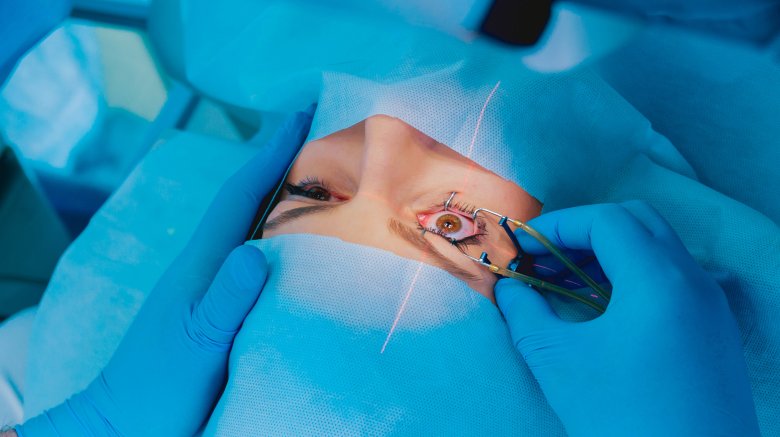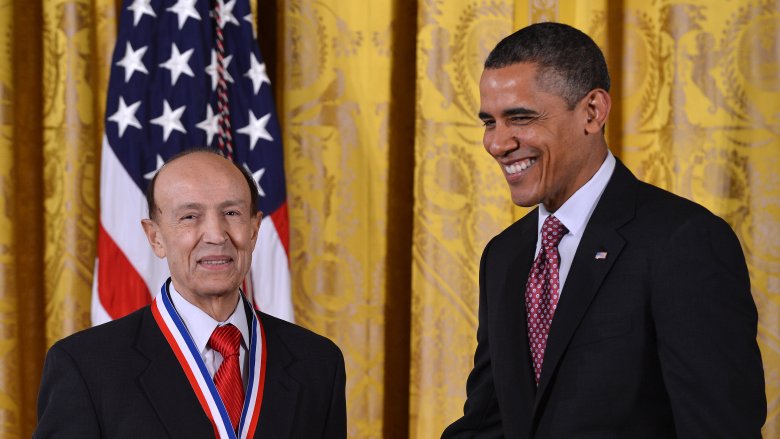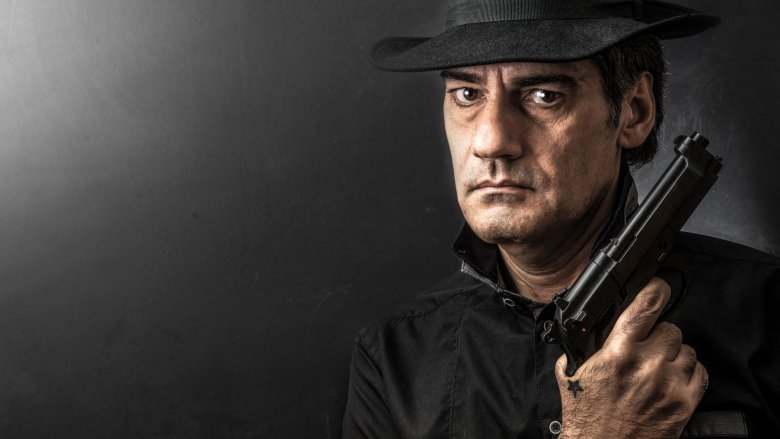The Untold Truth Of Lasik Surgery
Lasik surgery is the best thing since sliced eyeballs. In fact it's better than sliced eyeballs because it doesn't sound like something a serial killer would do. Short for laser-assisted in situ keratomileusis, Lasik entails cutting a flap in somebody's eye with a mechanical blade or a laser and then using brief laser bursts to vaporize portions of the cornea. While that might sound like an elaborate ploy to shine a glorified laser pointer in someone's eye, it's apparently helps the near-sighted see farther and astigmatism sufferers be less, uh, stigmatized?
Though not the only kind of laser eye surgery, Lasik is the most widely known. And if you ask the Lasik Vision Institute, it's the most popular refractive eye surgery overall. As the biggest rock star in the world of vision correction, Lasik necessarily comes with controversy and an unhealthy amount of drinking. And somehow a hit man factors into all of this. Here's the untold truth of Lasik surgery.
Before Lasik came along, doctors sliced eyes with diamond knives
Having someone vaporize part of your eyeball with a laser seems like a great way to go blind, and the process looks way too much like the torture scene from A Clockwork Orange. But it's not nearly as daunting as what eye surgeons did before Lasik existed. The previous go-to procedure was the radial keratotomy, which entailed making between 4 and 32 "deep cuts" in someone's eye with a diamond knife to alter the shape of the cornea. The Vision Eye Institute likens it to slicing a pizza.
Although it may sound delicious, slicing someone's eye like a pizza comes with some nasty risks such as infection or accidentally cutting too deep. It also makes your eyeballs more sensitive to changes in elevation, which mountaineer Beck Weathers learned in ghastly fashion when he tried to scale Mount Everest in 1996. As detailed by the Guardian, shortly after undergoing a radial keratotomy, Weathers attempted to conquer the world's highest mountain. Once he got too high his corneas changed shape, partially blinding him when it got dark. Stranded in freezing temperatures, Weathers lost both hands to frostbite.
While Lasik comes with its own set of risks, it's safer and more precise than radial keratotomy. And according to Dr. David Wallace, the comparatively superficial nature of laser-based eye-sculpting avoids elevation-related difficulties.
Lasik's inventor has a ridiculous number of other achievements
Gholam Peyman was such a quintessential visionary that he decided to become an eye expert. Born in Iran, Peyman studied medicine in Germany and moved to the U.S. to further his training. Though he specialized in eye diseases, he also considered vision problems in engineering and pharmacological terms. Those three interests came together like an intellectual Voltron to create Lasik surgery, which Peyman patented in 1985.
If most people invented a world-changing medical procedure, they'd probably spend the rest of eternity bragging about that one accomplishment. But Peyman didn't know the meaning of "quit upstaging the whole human race." In addition to proving that lasers are good for more than entertaining cats, he also helped develop a way to administer drugs via people's eyeballs that has proven vital in treating ocular diseases. Unfortunately, it involves inserting a needle into someone's eye, which ... ick, ya know? Maybe that's why everyone chooses to remember him for Lasik instead.
When he wasn't slightly annihilating eyeballs or very carefully stabbing them, Peyman was writing 10 books, publishing (at least) 879 scientific papers, amassing over 120 patents, training more than 200 doctors, and being honored by President Obama. Some people just can't stop.
Would you rather go blind or price-gouge your eyes out?
During the 1980s, laser eye correction began to replace more stab-intensive procedures. In 1989 Canada approved the excimer lasers used in Lasik, and the U.S. followed suit in 1996. Though Canada had a head start, America was determined to take the lead. And as the LA Times described, the heat of competition was blistering.
Instead of doing the reasonable thing and having patients get one eye corrected in each country so they could see the difference in quality for themselves, the vying doctors decided to badmouth each other. Canada's eye surgeons accused their Yankee counterparts of robbing patients blind. The Americans hit back by claiming Canadian Lasik surgeons might literally blind their patients. One doctor wasn't remotely subtle about it: "Would you go to a foreign nation for a thyroid operation? Probably not. More people fear blindness than fear death, so it's interesting so many people would be willing to risk it."
Was either side telling the truth or just plain full of it? It's a little of Column Eh and a little of Column B.S. Doctors in the U.S. charged many times more than Canadians but that was partly because of patent-related royalty fees. And while there were a few glaring examples of inferior eye care in Canada, America is no stranger to awful doctors.
Are Lasik skeptics correct or just wearing thorn-colored glasses?
Between 2007 and 2015 something huge happened in the world of Lasik surgery. As detailed by the Chicago Tribune, the number of people undergoing laser-based corrective eye surgery plummeted by over 50 percent. Nobody knows why, but the president of the American Society of Cataract and Refractive Surgery named economic hardship and millennials disliking Lasik as possible causes.
Another possibility is that potential patients are being dissuaded by online horror stories of people who've suffered debilitating eye pain, badly impaired vision, and burning sensations. Additionally, preliminary findings by an FDA official suggest that up to 45 percent of patients develop vision symptoms they didn't have prior to Lasik surgery. That stat was disputed by Dr. Daniel Durrie, who claimed the correct figure (as of 2016) was 23 percent. Then again, Durrie founded a Lasik-focused business, so he might have a dog in the fight.
The oft-cited Journal of Cataract and Refractive Surgery reported that 96 percent of Lasik patients are pleased with the results. That journal, it turns out, is run by the American Society of Cataract and Refractive Surgery, which Daniel Durrie is part of. That society serves on the American Refractive Surgery Council, a group of corporations and medical professionals whose earnings are affected by Lasik's popularity. Maybe that's a conflict of interest or just an innocent, conveniently lucrative arrangement. We'll let you decide.
The rare but horrifying side effects
Citing the Journal of Cataract and Refractive Surgery, the New York Daily News noted that the vast majority of Lasik patients don't regret getting the procedure. A cynic might point out that that's the official journal of the American Refractive Surgery Council, which has a vested interest in boosting Lasik sales. But even if we assume the research is both accurate and not misleadingly reported for financial reasons, Lasik's downsides can be horrific.
Military veteran Max Cronin had to drop out of college and stop driving after Lasik surgery left him in immense pain. He said it felt like "needles sticking into his eyes continuously." Paul Fitzpatrick endured 20 years of agony after what he deemed a botched laser surgery and wrote that he couldn't "experience any type of pleasure anymore." And meteorologist Jessica Starr experienced persistent foggy vision and a recovery she described as "brutal." Sadly, all three individuals committed suicide.
It would be unfair and irresponsible to suggest that Cronin, Starr, and Fitzgerald's struggles are typical of what happens when Lasik goes awry, and we don't know what else they might have been going through. But a rare tragedy is still a tragedy, and assessing the severity of Lasik's side effects might be tough because doctors sometimes dismiss serious complications as minor.
If you or anyone you know is having suicidal thoughts, please call the National Suicide Prevention Lifeline at 1-800-273-TALK (8255).
Even a 'successful' surgery might screw up your night vision
When it comes to Lasik, success is literally in the eye of the beholder, specifically the beholder's cornea. You might assume that a "successful" procedure results in flawless or almost-flawless vision. If that's what you thought, then we have a surprise for you. According to the British Journal of Ophthalmology, Lasik surgeries that effectively relieve the symptoms of near-sightedness and astigmatism can cause oddities in the cornea that produce a halo effect. Sadly, that doesn't mean patients see angels, but they will literally see the light, or more specifically halos around lights at nighttime. Others might see starbursts. One researcher found that 43.5 percent of patients in his study experienced night vision disturbances.
The BJO's research was from 2007, so maybe their data is outdated. Or maybe not because a 2016 study covered by Live Science found that over 40 percent of Lasik patients saw glares, halos, starbursts, or double-images three months after surgery. Ophthalmologist Christopher Starr, who wasn't involved in the study, told UPI that the symptoms subside within a year. However, ABC reported that Lasik-related complications can be permanent.
Not every Lasik patient is bothered by the side effects, but they can obviously be a problem if you need to drive at night or, say, fly an airplane. In 2004 former aviator Steve Post was awarded more than $4 million in court after Lasik surgery ruined his night vision and cost him his job.
The sales practices can get hella shady
Lasik surgery is an elective procedure, so the risks that come with it are taken voluntarily. Of course, that statement is only meaningful if patients know what the risks are, and Lasik providers aren't always eager to divulge the details. After all, if people don't need Lasik, they need to be sold on it.
In 2014 Britain's biggest provider of laser-based corrective eye surgery, Optical Express, was embroiled in controversy after a leaked manual revealed just how hard the company tried to sell Lasik other surgeries. The document directed providers to maximize personal connections with potential patients while minimizing mention of the potential pitfalls. A consumer watchdog investigated Optical Express' actual practices and found that it didn't disclose possible complications to patients.
The U.K. isn't alone in trying to sell medical procedures like they're Direct TV. In 2001 the Washington Post reported that a branch of Laser Vision Institute, one of America's largest Lasik providers at the time, paid sales commissions for nonrefundable deposits from customers and required sales counselors to close 75 percent of deals to receive perks. That's super problematic because an estimated 15-25 percent of people should be deemed ineligible. U.S. facilities are legally obligated to reveal possible side effects of Lasik surgery, but NPR noted the disclosure sometimes takes the form of fine print that patients don't read or can't comprehend.
Is Lasik basically eye-doping for athletes?
One of the beauties of Lasik is its precision. Surgeons can sometimes tweak a person's eyes until they have better than 20/20 vision. This could give pro athletes a competitive edge over normal-sighted rivals. Realizing this, master golfer and subpar husband Tiger Woods used Lasik to give himself 20/15 vision. That means objects that would normally come into focus when viewed from 15 feet away became clear to Woods from 20 feet away. In other words, he gave himself a 5-foot visual advantage compared to a generic competitor with 20/20 vision. The decision of Woods and other athletes to acquire laser-enhanced eyesight prompted Slate to ask the question: Why isn't that cheating?
If you take a drug that makes you stronger or faster, you get banned and stripped of your ill-gotten glory. But eyesight is also essential to victory in sports. In Woods' case, he went from losing 16 tournaments before Lasik surgery to winning seven of his next 10 afterward. Pro football, basketball, and baseball players have all reaped huge benefits from Lasik-adjusted vision. Skier Bode Miller partly blamed a disappointing showing at the 2014 Winter Olympics on not getting Lasik surgery. Yet speed skater Chris Creveling (above), who reportedly credited Lasik with helping him win a silver medal at those same Olympics was later banned for using a female fertility drug to boost his testosterone levels. Some people might not see a huge difference between those two enhancements.
Tiger Woods' eye surgeon worked for 'the McDonald's of Lasik'
Ever since Rocky III people have equated the "eye of the tiger" with winning. But Dr. Mark Whitten helped Tiger Woods win golf tournaments with Lasik-corrected eyes. Apparently not one to rest on his laurels, Whitten rested on Woods' laurels to help him promote TLC Laser Eye Centers. This made various ophthalmologists roll their eyes, per the LA Times.
It seemed misleading to suggest that patients would be able to see like a famous athlete, especially since Lasik's effectiveness depends heavily on the practitioner. As one eye expert put it, "The doctor who did Tiger Woods obviously is very good. That's one doctor in the TLC organization. Are the other doctors at the same level?" But also ... was Tiger Woods' doctor "very good"? The patients who sued him would say no. in 2003 Kashmira Karanjia accused Whitten of falsifying medical records to list her as a viable candidate for a Lasik surgery that ruined her night vision. In 2011 a court ordered Whitten to pay over $1 million to David Cantalupo after Lasik made his vision blurrier.
Were the TLC eye centers overall any good? Well, a lawyer called one TLC facility "the McDonald's of Lasik" because procedures were executed in quick, shoddy succession. One of its patients won $7.25 million in a lawsuit because Lasik-induced vision problems made him leave his high-paying job. In court the doctor responsible was called "the Darth Vader of Lasik."
Fraud as the eye can see
The ideal Lasik surgeon would be a well-trained, well-meaning professional who wouldn't hurt a fly's eye, let alone a patient's. Dr. Vikas Jain was none of those things. A man whose moral compass pointed south, Jain was the first eye surgeon in Ohio history to be disciplined by the state medical board, according to the Las Vegas Review-Journal. Among his many transgressions, he performed cataract surgery on a blind woman and Lasik surgery on someone with perfect vision. He also confessed to drinking before operating on people. Overall, he caused "substantial harm" to more than 20 patients. Since he was licensed in six states, there's no telling how many people he actually hurt.
Jain lost his Ohio medical license, moved to Sin City, and continued being the worst kind of awful. Using an alias and his wife's medical license, he ran the Valley Eye Center, where he wreaked ocular havoc on people like Mary Lydich. Lydich told Las Vegas Now that a Lasik operation blinded her in one eye and distorted her vision in the other. At least 30 patients claimed procedures they received at Valley Eye Center worsened their eyesight.
Just what the doctor ordered: a hit man
Business is usually a dog-eat-dog world, but wouldn't it be nice if the Lasik business were full of good doggies that don't commit cannibalism? Medicine shouldn't be vicious. Dr. Michael Mockovak, however, was as rabid as it gets. Mockovak opened a chain of eye surgery centers called Clearly Lasik with his brother-in-law Dr. Joseph King. The men were so close they even lived near each other, according to the Seattle Post-Intelligencer. However, their relationship frayed when business stopped booming and Mockovak divorced King's sister-in-law. Between 2007 and 2008 earnings dropped by over 40 percent, per the Seattle Times, and it appeared that King planned to divide the company. Additionally, the company's former president Brad Klock sued after being fired.
Mockovak asked a Ukrainian employee to find a Russian hit man to murder Klock over the lawsuit but changed his mind ... and decided to kill King because of the business split. Unaware that his employee was an FBI informant, Mockovak tried to make a $10,000 down payment to have someone drown his longtime pal and onetime brother-in-law during a family vacation. In court he claimed he was joking. The judge laughed at his defense and sentenced him to 20 years behind bars.
After surgery you might still need glasses
Lasik has freed many a patient from the hassle of having to wear glasses, but not everyone who gets it kisses their eyewear goodbye. Per the Vision Eye Institute, there are three main reasons a person might have to wear glasses after Lasik: They have a high prescription, the surgeon might suck, or they're just getting old.
The first reason might sound weird because the whole point of Lasik is to improve people's vision. But a high prescription could indicate that someone has a less stable eye shape, so after surgery their vision could worsen over time because the cornea develops new defects. The second reason basically acknowledges that some doctors are incompetent or will knowingly operate on your eye even if you wouldn't benefit from it. The Vision Eye Institute suggested going to "reputable clinics" to reduce the chances of a botched or unnecessary Lasik surgery. And the third reason is simple biology. Once you're about 40 years old your eyesight will degrade as your body makes an ever-quickening, depressingly irreversible march toward oblivion. That doesn't mean you shouldn't get Lasik if you're pushing middle age, but don't expect to bid your glasses farewell.












